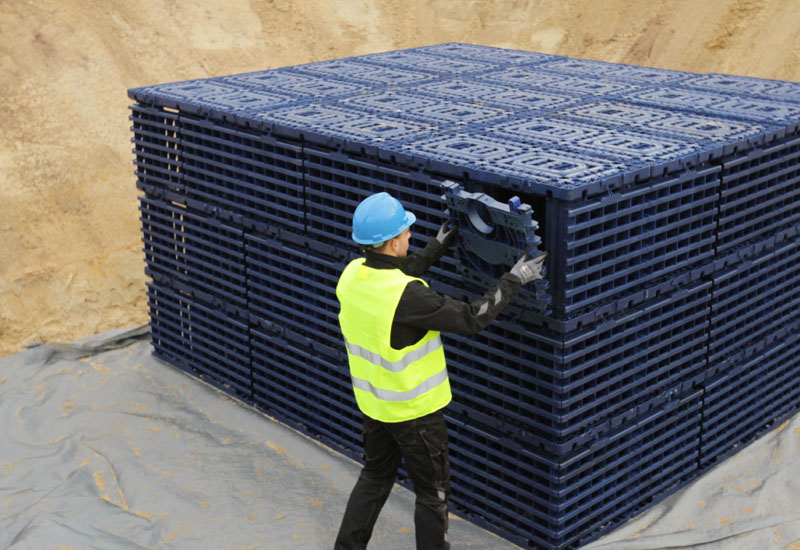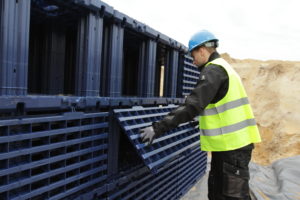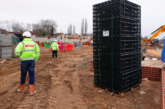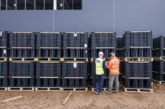
Martin Lambley Product Manager – Foul, Utilities and Water Management at Wavin examines the issues around stormwater management.
According to the UK Home Builders Federation during 2014/15 there were 170,000 additions to the housing stock, an increase of almost 25% on the previous year; the main being 155,000 new builds. Even with this rapid expansion, the UK is some way off of the 250,000 homes per year that are needed over a sustained period to more effectively meet demand.
 If all of the UK targets are to be achieved, it will place a serious strain on the UK’s increasingly stressed infrastructure, especially water and drainage. The UK’s changing climate, intensive rainfall and urban development all combine to show that rainwater is an issue that just won’t dry up without proper investment and planning. It’s also an issue housing developers have to take very seriously if they want to manage water ‘at source’ and reduce demand on built drainage and the sewerage infrastructure.
If all of the UK targets are to be achieved, it will place a serious strain on the UK’s increasingly stressed infrastructure, especially water and drainage. The UK’s changing climate, intensive rainfall and urban development all combine to show that rainwater is an issue that just won’t dry up without proper investment and planning. It’s also an issue housing developers have to take very seriously if they want to manage water ‘at source’ and reduce demand on built drainage and the sewerage infrastructure.
Thanks to the wide range of methods available with a Sustainable Drainage Systems (SuDS) approach, developers and planners can consider local land use, future scenarios, and the needs of local people when undertaking the drainage design – helping to deliver the highest quality results. And in the majority of cases, a combination of these techniques will result in best practice.
There are a number of options from natural above ground SuDS solutions including, detention ponds, basins and permeable surfaces to engineered solutions such as concrete culverts, plastic pipes, attenuation tanks and soakaways.
Housing & SUDS
With an increased focus on SuDS compliance, there has been a sharp increase in the use of geocellular stormwater management units to create underground structures for infiltration or the temporary storage of stormwater.
Q-Bic Plus from Wavin is a tried and tested modular technique for managing excessive rainfall. The modular nature of Q-Bic Plus makes it perfect for dealing with any given requirement, from just a few units acting as a soakaway, to thousands of units creating a vast underground reservoir. Q-Bic Plus has been designed for use whatever the soil type or available area, as it offers integrated vertical access points and a range of connection options.
More than five-million Wavin infiltration and attenuation units have been successfully installed all over the world, helping to prevent damage to infrastructure and threats to public health from flooding.
Flexibility in both in tank orientation and layout, as well as with connection options, laterally and vertically means better access points to the bi-directional inspection channels.
Faced with rising costs and stricter deadlines, modularisation is growing in popularity as contractors look to find the next generation of efficient and economical products and systems. Due to the numerous benefits both on and off site, modular rainfall management has become an increasingly popular choice at every stage of the supply chain, from the architect and specifier to the contractor and client.
Wavin’s Q-Bic Plus speeds up installation significantly, saving valuable time during construction and space on the building site. With integrated connectors ensuring push fit installation that simply clicks into place, there is no need for the clips and shear pins of other systems. Its lightweight construction means it’s easy to handle with a lightweight base unit, rounded edges, dedicated handgrips and walkable top deck.
Thanks to its compact, modular design, Wavin’s Q-Bic Plus means fewer deliveries to site, saving valuable time and resources on complex or large-scale installations.
Tank manager
A high-strength, factory-engineered, geocellular stormwater management unit can be constructed to accommodate calculated run off volumes, thus providing greater assurances to developers, authorities adopting the drainage systems, home owners and insurers alike.
The fact that these tanks are buried allows the land above them to be used to create amenity and biodiversity. This potential for land use above these systems is far safer and more valuable to many in society in terms of amenity than large ponds or basins.
From individual houses to large scale housing/commercial schemes, geocellular units can work in association with traditional SuDs solutions to provide the most effective flood protection possible for the long term.









